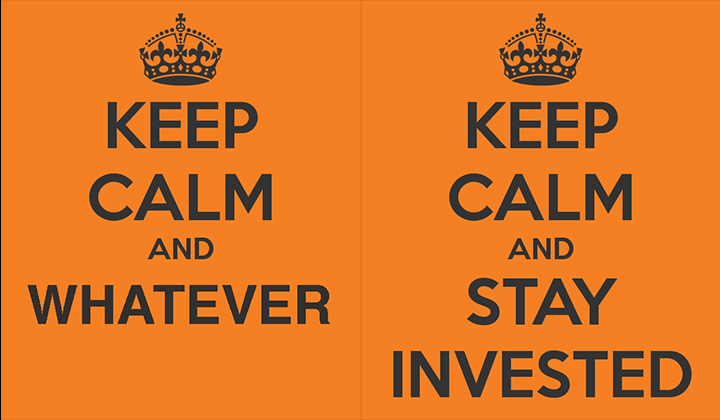



Posted: January 21, 2016 | by: Thomas F. McKeon, CFA
The stoic British have given the world a wonderful phrase and mindset, particularly as it relates to investing.
 Tweet
Tweet
A Word About Market Volatility:
To Our Veteran Clients: You have been here before. You know that enduring occasional market volatility is the price of reaching your long-term investment objectives. You know that your allocation, diversification and our hedged strategies take much of the sting out of market volatility. The options we use to hedge your portfolio actually benefit from higher volatility, collecting greater premium when investor anxiety is high. So while market volatility is unpleasant, you are not taking it lying down, and neither are you unduly worried about short-term portfolio fluctuations. KEEP CALM and WHATEVER.
To Our Newer Clients: Welcome to Market Volatility. Welcome also to the endless stream of financial media bombast driven solely by their need to generate ratings and not whatsoever by a need to responsibly inform investors. Volatility is a permanent aspect of the markets and investing. As a long-term investor, you will endure occasional market declines, some of them quite sharp. You will get used to it. In addition, our hedged strategies take advantage of elevated market volatility by collecting greater option premium on our monthly hedge-roll. This simple, methodical process enhances your returns, buffers your downside risk, limits drawdowns and helps your portfolio recover more quickly. So while occasional volatility is unpleasant in real-time, you too will learn that your asset mix, diversification and hedged strategies take the sting out of downside market volatility and allow you to stay invested. And that is the only way to meet your long-term investment objectives. KEEP CALM and STAY INVESTED. This too shall pass.
A Word About Oil
Oil is a commodity. We tend to agree with the venerable John Bogle—Founder of the Vanguard Family of Funds—that since commodities have no internal rate of return; no earnings, profits or dividends; no balance sheet, don’t issue debt and hence make no interest payments—that investing in them is a little dicey. There are no internal cash flows to gauge valuation.
The other side of that coin is that commodities can’t go broke, can’t have a negative net worth, can’t declare bankruptcy, can’t default on a bond payment or fail to make a dividend payment. They are priced purely on supply, demand and aggregate investor emotion.
Having traded at $100/barrel last year, oil has fallen to just over $25/barrel. For those of you (like me) who were permanently scarred by “New Math” in the 1960s, that is a 75% decline in the price of that commodity. Most US citizens and businesses are net consumers of energy. We need energy for our cars, devices, homes, offices, factories, etc. Filling your tank at the pump one or more times a week for half of what it cost last year is an unequivocal good thing. Spending less on gasoline leaves room in the budget for other saving, investment or consumption. That figures to be a net positive for households and the economy.
The price of oil is not going to zero. At some point, the price will find a supply and demand equilibrium and stop falling. Regardless of when and where that price is reached, oil as an investment currently appears to offer an attractive asymmetric opportunity. At just above $25/barrel, oil may have 25% downside risk to $20/barrel, give or take. It is probably not headed straight back to $100/barrel but could easily reach $50 or $60 per barrel, offering 100% or more in gains. A little patience will be rewarded as US energy demands grow and oil supply falls as high-cost producers leave the field.
So while the pundits and talking heads focus on oil as one of the proximate causes for recent market volatility, most of us consumers welcome the drop in oil prices. Investors should too.